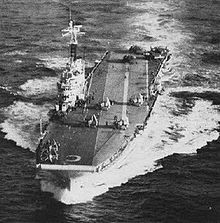- Operation Vantage
-
Operation Vantage 
HMS Centaur in 1955Planned by  British military
British militaryObjective Support Kuwait independence Date 1 July 1961 Executed by British Army
Royal Air Force
Royal NavyOutcome Iraq recognised Kuwait in 1963 Operation Vantage was a British military operation in 1961 to support the newly independent state of Kuwait against territorial claims by its neighbour, Iraq. Britain reacted to a call for protection from the Amir of Kuwait and air, sea and land forces were in place within days. Iraq did not attack and the British forces were replaced by the Arab League. Iraq recognised Kuwaiti independence in 1963.
Contents
Background
In 1958, Abdul Karim Qasim seized power in Iraq. He was seen by western powers as unpredictable and Iraq as unstable. On 25 June 1961, following Britain's relinquishing authority in Kuwait, Qasim announced that Kuwait would be incorporated into Iraq and the military threat was seen, by Britain, as imminent.[1] The reasons for Iraqi belligerence are debatable, but as well as the political gain to be accrued from a successful military campaign, Kuwait's assets at the time included possible oil reserves (confirmed later) and secure access to the sea, which Iraq lacked.
The operation
Britain had accepted responsibility for Kuwait's military protection[1] and urgently sent a strong naval task force which included Royal Marines from 42 Commando, on HMS Bulwark, aircraft carrier HMS Victorious (subsequently relieved by HMS Centaur), destroyers HMS Camperdown, HMS Finisterre, HMS Saintes and HMS Cassandra, frigates HMS Loch Fyne, LST Hawker Hunters arrived.[2] By 1 July Britain had half of a brigade group in Kuwait ready for action. These included 42 and 45 Marine Commandos and two companies of 2nd Coldstream Guards. 3rd Carabiniers' "C" squadron landed with their Centurion tanks from Mitla Ridge, near the Iraqi border, in fierce summer heat.
In the following days, there were further reinforcements; an artillery battery of the 33rd Parachute Field Regiment, and the 11th Hussars with Ferret scout cars; 2nd Battalion, The Parachute Regiment arrived after a delay through difficulties over-flying Turkey. On 4 July, the 1st Battalion, Royal Inniskilling Fusiliers and the 34th Field Squadron arrived from Kenya. The Inniskillings and the 1st Battalion, The King's Regiment (Manchester and Liverpool) relieved 42 and 45 Commandos on 6 and 7 July. There more reinforcements from the UK.[3]
Aftermath
The Arab League took over the protection of Kuwait and the British had withdrawn its forces by 19 October.[3] Qasim was killed in a coup in 1963 but, although Iraq recognised Kuwaiti independence and the military threat was perceived to be reduced, Britain continued to monitor the situation and kept forces available to protect Kuwait until 1971. There had been no Iraqi military action against Kuwait at the time: this was attributed to the political and military situation within Iraq which continued to be unstable.[1]
References
- ^ a b c Mobley, Richard A. (2007/2008). "Gauging the Iraqi Threat to Kuwait in the 1960s - UK Indications and Warning". Central Intelligence Agency. https://www.cia.gov/library/center-for-the-study-of-intelligence/csi-publications/csi-studies/studies/fall_winter_2001/article03.html. Retrieved 17 Jan 2010.
- ^ White, Christopher J; Robinson, Peter (2008–2010). "Gulf War Part 1: Operation Vantage". Historical RFA. http://www.historicalrfa.org/rfa-conflicts. Retrieved 16 Jan 2010.
- ^ a b James Paul & Martin Spirit; Robinson, Peter (2008). "Kuwait: The first crisis 1961". Riots, Rebellions, Gunboats and Peacekeepers. http://www.britains-smallwars.com/RRGP/Kuwait.htm. Retrieved 17 Jan 2010.
Categories:- Military operations involving the United Kingdom
- History of Kuwait
- Iraq–United Kingdom relations
Wikimedia Foundation. 2010.
